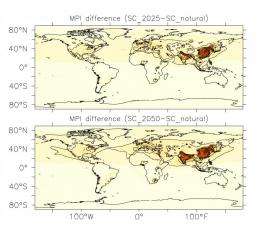Cut emissions further or face risks of high air pollution, study shows

Most of the world's population will be subject to degraded air quality in 2050 if man-made emissions continue as usual. In this 'business-as-usual' scenario, the average world citizen 40 years from now will experience similar air pollution to that of today's average East Asian citizen. These conclusions are those of a study published today in Atmospheric Chemistry and Physics, an Open Access journal of the European Geosciences Union (EGU).
Air pollution is a major health risk that may worsen with increasing industrial activity. At present, urban outdoor air pollution causes 1.3 million estimated deaths per year worldwide, according to the World Health Organisation [1].
"Strong actions and further effective legislation are essential to avoid the drastic deterioration of air quality, which can have severe effects on human health," concludes the team of scientists, led by Andrea Pozzer of the Abdus Salam International Centre for Theoretical Physics in Italy (now at the Max Planck Institute of Chemistry in Germany), in the new paper.
The researchers studied the impact of man-made emissions on air quality, assuming past emission trends continue and no additional climate change and air pollution reduction measures (beyond what is in place since 2005) are implemented. They point out that, while pessimistic, the global emissions trends indicate such continuation.
"At present the post-Kyoto climate negotiations are progressing slowly, and it is unclear how air quality policies will develop globally," explains co-author Greet Janssens-Maenhout of the European Commission Joint Research Centre in Italy. "In regions with economic growth, it might be less effective to implement emission-reduction measures due to strong growth in activities in particular sectors; in countries suffering from the economic downturn, implementing expensive air-quality measures could prove difficult in coming years," she adds.
"We show that further legislation to control and reduce man-made emissions is needed, in particular for eastern China and northern India, to avoid hot-spots of elevated air pollution," says Pozzer. Combined with the fact that these are regions of high population density, elevated air pollution here would mean that air quality would worsen significantly for the average world citizen in 2050.
Air pollution would also increase in Europe and North America, but to a much lesser extent than in Asia, due to the effect of mitigation policies that have been in place for over two decades.
Pozzer and his colleagues estimated air quality in 2005, 2010, 2025 and 2050 using an atmospheric chemistry model. "The model uses basic mathematical formulation to predict the meteorology and the chemical composition of the atmosphere," Pozzer explains. "In practice, it is a software used to forecast – or hindcast, for past years – the status of the atmosphere at specific times."
The results show that in 2025 and 2050, under the business-as-usual scenario studied, East Asia will be exposed to high levels of pollutants, such as nitrogen dioxide, sulphur dioxide and fine particulate matter (PM2.5) [2]. Northern India and the Arabian Gulf region, on the other hand, will suffer a marked increase in ozone levels.
The analysis now published is the first to include all five major air pollutants know to negatively impact human health: PM2.5, nitrogen dioxide, sulphur dioxide, ozone, and carbon monoxide. The scientists considered pollutants released through human activity, as well as those occurring naturally such as desert dust, sea spray, or volcanic emissions.
Taking all pollutants into account, eastern China, northern India, the Middle East, and North Africa are projected to have the world's poorest air quality in the future. In the latter locations this is due to a combination of natural desert dust and man-induced ozone. The effect of anthropogenic pollution emissions are predicted to be most harmful in East and South Asia, where air pollution is projected to triple compared to current levels.
The study aimed to compare the influence of man-made emissions on air quality in different regions, and show how no-further legislation to reduce emissions can result in drastic deterioration of air quality worldwide compared to the present day situation.
More information: [1] World Health Organisation (WHO) 'Air quality and health' fact sheet (September 2011) www.who.int/mediacentre/factsh … /fs313/en/index.html
[2] PM2.5 refers to pollutant particles less than 2.5 micrometers in aerodynamic size, or about a quarter of the size of a cloud droplet. According to the WHO, "PM affects more people than any other pollutant." PM2.5 is more dangerous than particulate matter of larger size because these particles can reach the smallest of airways and interfere with gas exchange in the lungs. (Source: www.who.int/mediacentre/factsh … /fs313/en/index.html)
This research is presented in the paper ‘Effects of business-as-usual anthropogenic emissions on air quality’ to appear in the EGU Open Access journal Atmospheric Chemistry and Physics on August 1, 2012.
The scientific article is available online, from the publication date onwards, at www.atmos-chem-phys.net/recent_papers.html. To receive a copy of the peer-reviewed paper before publication, please contact the EGU Media and Communications Officer.
The discussion paper (not peer-reviewed) and reviewers comments is available at www.atmos-chem-phys-discuss.ne … 2012-discussion.html.
Journal information: Atmospheric Chemistry and Physics
Provided by European Geosciences Union

















